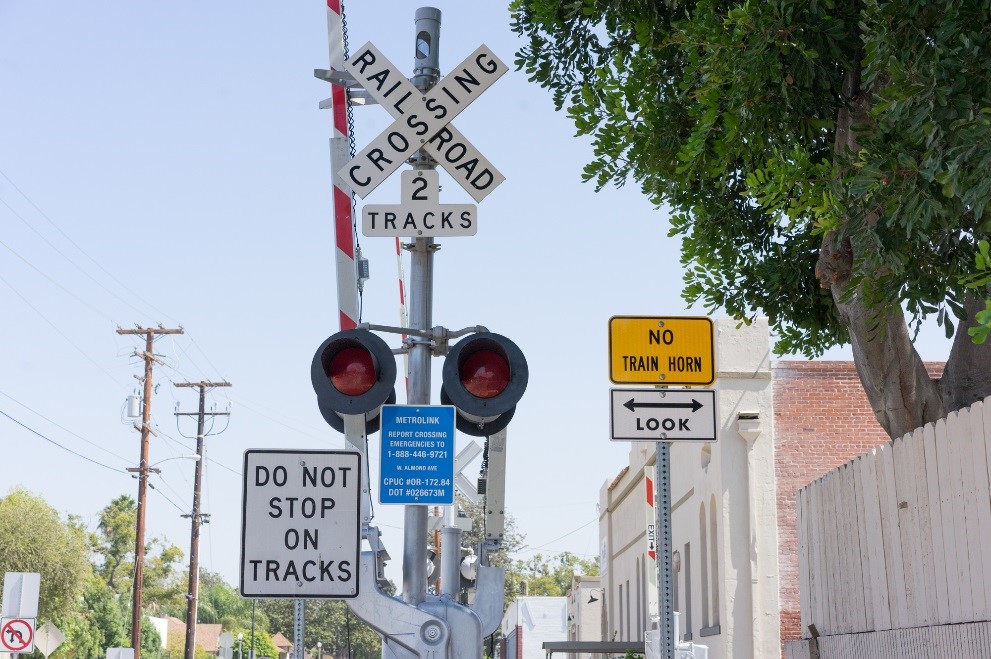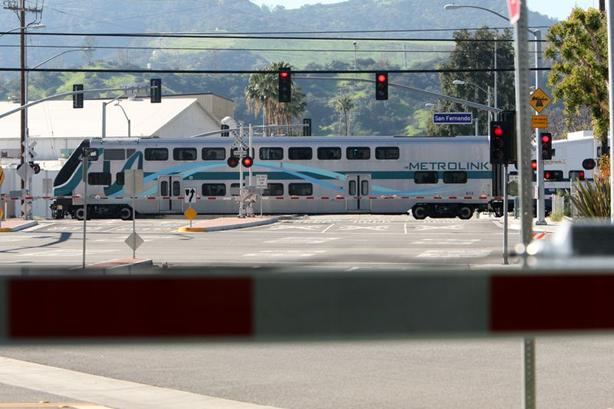Quiet Zones
We get it, while you may love our service you may prefer not to hear our horns. Metrolink and all other railroads are required by federal law to honk their horns unless the crossing is grade separated or in a Quiet Zone. Metrolink does not have the ability to create, pay for or approve a Quiet Zone in your community but we understand if you would like one. As part of the process, the City you live in has the power to create a Quiet Zone by requesting the Quiet Zone from the Federal Railroad Administration, making the improvements required by the FRA and accepting liability for the Quiet Zone.
WHAT IS A QUIET ZONE?
A Quiet Zone is a section of a rail line at least one‐half mile in length that contains one or more consecutive public highway‐rail grade crossings at which locomotive horns are not routinely sounded when trains are approaching the crossings after the installation of federally required and approved safety measures.


(from the U.S. Department of Transportation Federal Railroad Administration website: https://www.fra.dot.gov/Page/P0889)
Under the Train Horn Rule (49 CFR Part 222), locomotive engineers must begin to sound train horns at least 15 seconds, and no more than 20 seconds, in advance of all public grade crossings.
Federal law requires that if a train is traveling faster than 60 mph, engineers are required to sound the horn within a ¼ mile of the crossing and at the crossing.
There is a "good faith" exception for locations where engineers can’t precisely estimate their arrival at a crossing and begin to sound the horn no more than 25 seconds before arriving at the crossing.
Train horns must be sounded in a standardized pattern of 2 long, 1 short and 1 long blasts. The pattern must be repeated or prolonged until the lead locomotive or lead cab car occupies the grade crossing. The rule does not stipulate the durations of long and short blasts.
The maximum volume level for the train horn is 110 decibels which is a new requirement. The minimum sound level remains 96 decibels.
The final rule also provides an opportunity for localities nationwide to mitigate the effects of train horn noise by establishing “new quiet zones.” “No horn” restriction which may have existed prior to the establishment of the rule may be qualified to be “pre-rule quiet zones”. In a quiet zone, railroads have been directed to cease the routine sounding of their horns when approaching public highway-rail grade crossings. Train horns may still be used in emergency situations or to comply with other Federal regulations or railroad operating rules. Localities desiring to establish a quiet zone are first required to mitigate the increased risk by updating crossings to PUC standards to ensure safety caused by the absence of a horn.
Learn how to create a Quiet Zone here. Additional resources on Quiet Zones can be found on the Quiet Zone Resources tab.

A Metrolink train at a Quiet Zone railroad crossing.
Metrolink’s first priority is safety. Quiet Zones must meet all California Public Utility Commission (CPUC) and Federal Railroad Administration (FRA) guidelines. All public crossings in a Quiet Zone must be equipped with flashing lights, railroad protection gates, medians, wayside horns. Other improvements can also be required as necessary.
Metrolink supports the establishment of Quiet Zones. Metrolink will work with cities or communities interested in establishing Quiet Zones but, in order for a Quiet Zone to be implemented, the local agency must make the request to the PUC directly and be willing to accept liability for the Quiet Zone.
Based on the federal rules, Metrolink is required to blow horns at all crossings until Quiet Zones are established, regardless of the time of day. Additionally, it is important to note that even if a Quiet Zone is in place, an engineer may need to blow the horn for safety or railroad-related reasons. Train horns can and will be sounded in case of emergency situations.
Metrolink has worked with its member agencies: Los Angeles County Metropolitan Transportation Authority (METRO), Orange County Transportation Authority (OCTA), Riverside County Transportation Commission (RCTC), San Bernardino County Transportation Authority (SBCTA), and Ventura County Transportation Commission (VCTC) to create Quiet Zones. More information about existing Quiet Zones is below.
Take a Tour of Metrolink Quiet Zones
ORANGE COUNTY
Orange County is home to the nation’s largest railway Quiet Zone, spanning 34 railroad crossings in six cities not including Chestnut Avenue, Grand Avenue, Lyon Street, Ritchie Street in the City of Santa Ana and Harvard Avenue in the City of Irvine. As part of the effort to establish the Quiet Zone, safety enhancements were made to a total of 52 crossings in eight cities.
The Quiet Zone project was completed in 2012, and the entire process took seven years and cost $85 million. The Orange County Transportation Authority (OCTA) covered most of the cost through taxpayer-funded Measure M. The remaining 12 percent of costs were contributed by the cities, including liability costs.
Costs ranged from $1.5 million to $2.5 million per crossing. Typical safety enhancements in program included: extended and widened center medians, improved sidewalks; improved highway approach geometry; four-quadrant pedestrian gates and flashers; exit gates; pre-signals; queue-cutter signals; vehicle traffic signal system interconnections with advanced preemption; and reconstructed and lengthened highway-rail grade crossing surfaces.
In some cases numerous, minor right–of-way acquisitions (less than 1,000 square feet) were also required.
For more information about the Quiet Zones in Orange County click here.

A Metrolink train at a railroad crossing.
RIVERSIDE COUNTY
The Riverside Quiet Zone Projects are part of the City of Riverside’s efforts to mitigate the adverse noise impacts from the high volume of train traffic within the city. These Quiet Zones help to reduce train horn noise by eliminating the need for locomotives to routinely sound their horns. Please note that train engineers will still be required to sound a horn if they see a hazard on or near the tracks (such as people, animals, vehicles, etc.).
The first City of Riverside Quiet Zone went into effect on Thursday, November 17, 2016 at 12:01 a.m. The $13 million project was planned in 2007, with work officially starting in 2011. It extends over seven miles along the BNSF Railway line between Mary Street and Buchanan Street (running parallel to SR-91). With 12 at-grade crossings, this stretch of tracks averages more than 100 trains per day (including those operated by BNSF, Metrolink and Amtrak).
The City of Riverside’s second Quiet Zone is comprised of four crossings between Mt. Vernon Avenue and Marlborough Avenue on Metrolink’s 91/Perris Valley Line extension, a segment that averages 15 trains per day.
For more information about the Quiet Zones in the City of Riverside click here.
LOS ANGELES COUNTY
The cities of Pomona and Glendale located in Los Angeles county have Quiet Zones. The city of Burbank is set to finish establishing a quiet zone by the end of 2019.The city of Baldwin Park is actively seeking the establishment of a Quiet Zone.
City of Pomona
The Pomona Quiet Zone officially went into operation on Monday, September 24, 2007. The Quiet Zone is from San Antonio Avenue to Hamilton Boulevard, along the First Street Corridor. This Quiet Zone exists along Metrolink’s Riverside Line.
For more information about the Quiet Zones in the City of Pomona click here.
City of Glendale
Glendale is now one of the three cities in Los Angeles County with a Quiet Zone. Quiet Zones help to reduce train horn noise by eliminating the need for locomotives to routinely sound their horns. It covers almost a mile of railroad track along San Fernando Road at the Grandview Avenue, Sonora Avenue and Flower Street crossings.

A Metrolink train at the San Fernando Road Quiet Zone in Glendale.
SAN BERNARDINO COUNTY
Quiet Zones were established for Downtown San Bernardino Passenger Rail Project (DSBPRP) crossings in the City of San Bernardino. There is currently one quiet zone in San Bernardino County between the San Bernardino Depot and the San Bernardino-Downtown Station.
For more information about the Quiet Zones in San Bernardino County click here.
VENTURA COUNTY
more details to come
Riverside Line
- FRA Quiet Zone Brochure
-
 Metrolink’s Board-approved Quiet Zone Requirement Resolution
Metrolink’s Board-approved Quiet Zone Requirement Resolution -
 Metrolink’s Grade Crossing Standards
Metrolink’s Grade Crossing Standards
If you have any questions, concerns, or would like to make a report about trains adhering to Quiet Zone rules please contact Laurene Lopez at 213-452-0433, [email protected], or community hotline 213-452-0400.
